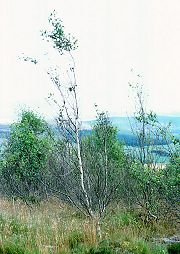Summary
Summary

As a major component of native woodlands throughout Scotland, birch is valued increasingly as a resource for conservation, habitat and landscape purposes. Both silver birch (Betula pendula) and downy birch (B. pubescens) are two of the more important broadleaved species in new native woodland planting and natural regeneration schemes in Scotland, of which 50,000 ha were created during the 1990s. However, widespread dieback of young birch was reported at an increasing number of sites from 1999/2000 onwards.
This project investigated the role of shoot fungi as causal agents of crown dieback of birch. Two primary pathogens on birch shoots were identified, Marssonina betulae and Anisogramma virgultorum, and their distribution and impact on birch were evaluated at planted and site-natural stands in Scotland. Both fungi were found to be widespread and contributing to the dieback of planted birch at upland sites in Scotland. Naturally regenerated birch, however, was largely free of these diseases at the surveyed sites. It is recommended to avoid planting silver birch (Betula pendula) at exposed sites given the high susceptibility of this species to M. betulae.
Research objectives
The main objectives of this project were to:
- Investigate the fungi infecting birch shoots in Scotland
- Identify the primary pathogens
- Determine the impact of these fungi on the national woodland resource
- Establish recommendations for managing the problem.
Surveys were carried out in 2002 at a number of new native woodland schemes in Scotland to describe the fungi colonising young shoots of birch. The pathogenicity of the most frequently occurring fungi was then evaluated on young birch trees in inoculation studies. Two fungal pathogens were identified as causal agents of shoot dieback of birch; these were Anisogramma virgultorum and Marssonina betulae.
The distribution and impact of A. virgultorum and M. betulae were evaluated in 2004 and 2006 at nine new native woodland schemes and six birch provenance trials planted in Scotland. Ninety site-natural stands of birch were also surveyed. These surveys demonstrated the widespread distribution of these two pathogens at planted sites and confirmed their importance as causal agents of crown die-back at these sites. The incidence and severity of these diseases were much lower at site-natural stands of birch.
Publications
De Silva, H., Castlebury, L.A., Green, S. and Stone, J.K. (2009). Characterisation and phylogenetic relationships of Anisogramma virgultorum and A. anomala in the Diaporthales (Ascomycota). Mycological Research 113: 73-81.
De Silva, H, Green, S. and Woodward, S. (2008). Incidence and biology of Anisogramma virgultorum on birch in Scotland. Scottish Forestry 62 (4), 22-28.
DeSilva, H., Green, S. and Woodward, S. (2008). Incidence and severity of dieback in birch plantings associated with Anisogramma virgultorum and Marssonina betulae in Scotland. Plant Pathology 57 (2): 272-279.
Green, S. and Castlebury, L.A. (2007). Connection of Gnomonia intermedia to Discula betulina and its relationship to other taxa in the Gnomoniaceae. Mycological Research 111:62-69.
Green, S., MacAskill and G.A. (2007). Pathogenicity of Marssonina betulae and other fungi on birch. Plant Pathology 56: 242-250.
Green, S. (2005). Birch die-back in Scotland (PDF-723K). Forestry Commission Information Note 72. Edinburgh, Scotland.
Green, S. (2005). First report of Septoria betulae causing leaf spot of birch in the United Kingdom. Plant Pathology 54 (4): 580.
Green, S. (2004). Fungi associated with shoots of silver birch (Betula pendula) in Scotland. Mycological Research 108 (11): 1327-1336.
Funders and partners
![]()
This research is funded by the Forestry Commission Advice and scientific support for tree health programme.

The Scottish Foresty Trust funded a 3-year PhD studentship on the distribution, impact and biology of Anisogramma virgultorum. This PhD programme was co-supervised by Dr Steve Woodward at the University of Aberdeen.
Forestry Commission policy
UK forestry policy has two main aims: the sustainable management of existing forests and woods and a steady expansion of woodland area to provide benefits for society and the environment. This project will significantly increase our knowledge of the pathology of an important native broadleaved species and factors leading to dieback, enabling future plantations to be managed more effectively to reduce the impacts of disease.
Status
The programme was undertaken from 2002 to 2006.
